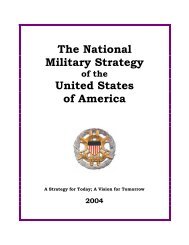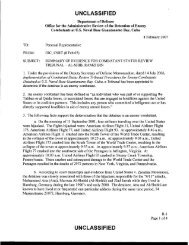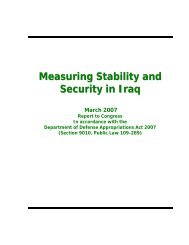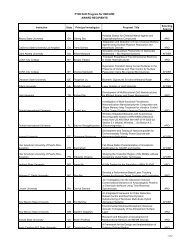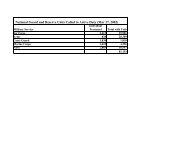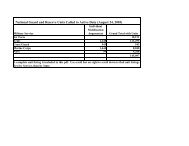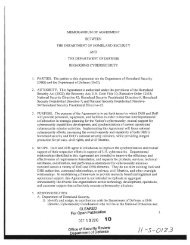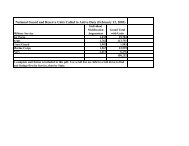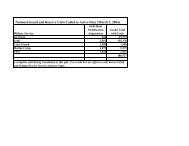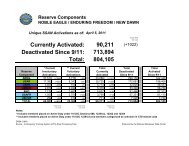Report - United States Department of Defense
Report - United States Department of Defense
Report - United States Department of Defense
You also want an ePaper? Increase the reach of your titles
YUMPU automatically turns print PDFs into web optimized ePapers that Google loves.
UNCLASSIFIED<br />
Both forces continued to struggle with NCO shortages, logistics, and various enabling<br />
capabilities, though these issues were anticipated and are being actively addressed, as discussed<br />
earlier in this report.<br />
ANSF Self-assessment<br />
ISAF is currently working jointly with the MoI and MoD to improve existing ANSF assessment<br />
tools. As ISAF personnel in theater decrease and more ANSF units are fielded, the proportion <strong>of</strong><br />
ANSF units that are partnered or advised will decline. As ISAF starts receiving fewer and fewer<br />
CUAT reports, it will require an additional system to inform leadership and the international<br />
community on progress within the ANSF. The ANSF itself will need an Afghan-run selfassessment<br />
system after 2014.<br />
This new system is intended to augment and improve Afghan reporting systems currently used<br />
by the ANA and ANP. The existing systems are the Readiness <strong>Report</strong>ing System (RRS), used<br />
by the ANA, and the Force Readiness <strong>Report</strong> (FRR), used by the ANP. Neither system, as<br />
currently designed, provides a sufficiently extensive assessment <strong>of</strong> the operational capabilities <strong>of</strong><br />
the ANSF. This is where improvement efforts are now focused. ISAF is also working to<br />
augment the existing ANSF capability to validate these assessments - a crucial part <strong>of</strong> any<br />
credible assessment system. These enhancements to the existing ANSF reporting systems require<br />
Afghan assistance to be fully developed, and they also require the support <strong>of</strong> senior MoD and<br />
MoI leadership to ensure successful implementation.<br />
During the reporting period, minimal progress was made in reforming the ANSF self-assessment<br />
system. However, a General Officer Steering Committee, and ANA and ANP Working Groups<br />
comprising Afghan and coalition leaders were established.<br />
2.12: 1221 BENCHMARK REQUIREMENT 24<br />
DoD has evaluated options for developing the ANSF more efficiently. In 2011, DoD conducted<br />
a comprehensive analysis to examine options for the development <strong>of</strong> the ANSF, and identified<br />
the minimum level <strong>of</strong> capabilities needed to establish and preserve security in Afghanistan.<br />
Options for ANSF development should be consistent with the Lisbon NATO Summit timeline,<br />
sufficient to support the core national security goals <strong>of</strong> the <strong>United</strong> <strong>States</strong>, and able to yield an<br />
ANSF structure that is sustainable within the limits <strong>of</strong> Afghan human capital, economic capacity,<br />
and the will <strong>of</strong> the international community to provide long term assistance.<br />
The current planned force <strong>of</strong> 352,000 combined ANSF personnel has been deemed necessary to<br />
complete the transition to full security responsibility to the Afghans by the end <strong>of</strong> 2014, and to<br />
secure the country during the transition <strong>of</strong> power following the Afghan presidential election in<br />
2014, while mitigating the effects <strong>of</strong> the U.S. and coalition partner drawdowns. In April 2012,<br />
the U.S. Secretary <strong>of</strong> <strong>Defense</strong> and the Afghan Ministers <strong>of</strong> <strong>Defense</strong> and Interior committed to<br />
conducting six-month reviews <strong>of</strong> the ANSF force structure and other needs. As Afghanistan<br />
continues to become more secure and stable through 2015-2016, GIRoA, in coordination with<br />
NATO and other partners will begin to refocus the ANSF toward enduring security roles, and it<br />
24 This section is submitted consistent with section 1221 <strong>of</strong> the National <strong>Defense</strong> Authorization Act for Fiscal Year 2012.<br />
107



